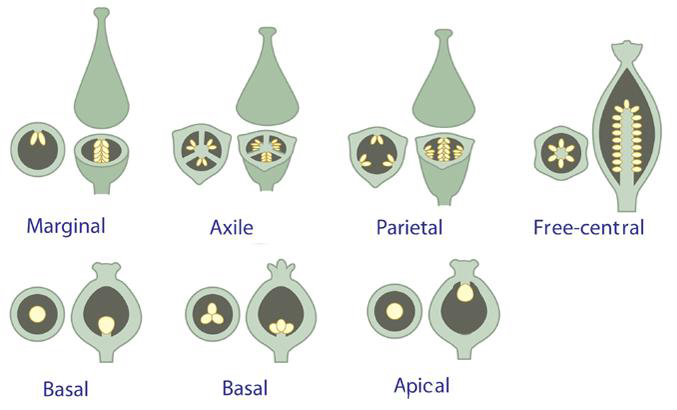
Free central placentation is present in
(a) Dianthus
(b) Argemone
(c) Primrose
(d) Both (a) and(b)
Answer
449.1k+ views
1 likes
Hint: This type of placentation is present in ovaries with a single locule where ovules are borne on a central axis. Placentation is the arrangement of ovules within the ovary.
Complete answer:
The type of placenta is found in the bicarpellary to multicarpellary syncarpous ovary. Here there is a generation of a false septum that in turn causes the ovules to be arranged on a central axis and makes the ovary unilocular. It is observed in plants like Dianthus or Primrose.
In plants placentation is of the following types:
Basal: this type of placenta is found commonly in plants that have monocarpellary to multicarpellary syncarpous ovary. Here a single ovule is attached to the base of the ovary. Examples are sunflower, marigold.
Parietal: this type of placenta is commonly found in plants that have bicarpellary to multicarpellary syncarpous ovary. A false septum is produced which makes a unilocular ovary bilocular. As observed in mustard and Argemone.
Axile: this type of placenta is found in bicarpellary to multicarpellary syncarpous ovary. The carpels in this ovary fuse and form a septum, this inturn forms a central axis as seen in china rose, tomato etc.
Marginal: this is a type of placenta is found in the monocarpellary unilocular ovary where placenta forms on the walls on the ovary on the ventral side and the ovules are arranged on a vertical axis like in peas.

So, the correct answer is Dianthus
Note:
Placentation further decides seed arrangement in the fruit and the number of seeds in a single fruit. Its characterization is done on the basis of whether the central column in the ovary is present or not.
Complete answer:
The type of placenta is found in the bicarpellary to multicarpellary syncarpous ovary. Here there is a generation of a false septum that in turn causes the ovules to be arranged on a central axis and makes the ovary unilocular. It is observed in plants like Dianthus or Primrose.
In plants placentation is of the following types:
Basal: this type of placenta is found commonly in plants that have monocarpellary to multicarpellary syncarpous ovary. Here a single ovule is attached to the base of the ovary. Examples are sunflower, marigold.
Parietal: this type of placenta is commonly found in plants that have bicarpellary to multicarpellary syncarpous ovary. A false septum is produced which makes a unilocular ovary bilocular. As observed in mustard and Argemone.
Axile: this type of placenta is found in bicarpellary to multicarpellary syncarpous ovary. The carpels in this ovary fuse and form a septum, this inturn forms a central axis as seen in china rose, tomato etc.
Marginal: this is a type of placenta is found in the monocarpellary unilocular ovary where placenta forms on the walls on the ovary on the ventral side and the ovules are arranged on a vertical axis like in peas.

So, the correct answer is Dianthus
Note:
Placentation further decides seed arrangement in the fruit and the number of seeds in a single fruit. Its characterization is done on the basis of whether the central column in the ovary is present or not.
Latest Vedantu courses for you
Grade 10 | CBSE | SCHOOL | English
Vedantu 10 CBSE Pro Course - (2025-26)
School Full course for CBSE students
₹37,300 per year
Recently Updated Pages
Master Class 9 General Knowledge: Engaging Questions & Answers for Success

Master Class 9 English: Engaging Questions & Answers for Success

Master Class 9 Science: Engaging Questions & Answers for Success

Master Class 9 Social Science: Engaging Questions & Answers for Success

Master Class 9 Maths: Engaging Questions & Answers for Success

Class 9 Question and Answer - Your Ultimate Solutions Guide

Trending doubts
State and prove Bernoullis theorem class 11 physics CBSE

What are Quantum numbers Explain the quantum number class 11 chemistry CBSE

Who built the Grand Trunk Road AChandragupta Maurya class 11 social science CBSE

1 ton equals to A 100 kg B 1000 kg C 10 kg D 10000 class 11 physics CBSE

State the laws of reflection of light

One Metric ton is equal to kg A 10000 B 1000 C 100 class 11 physics CBSE




